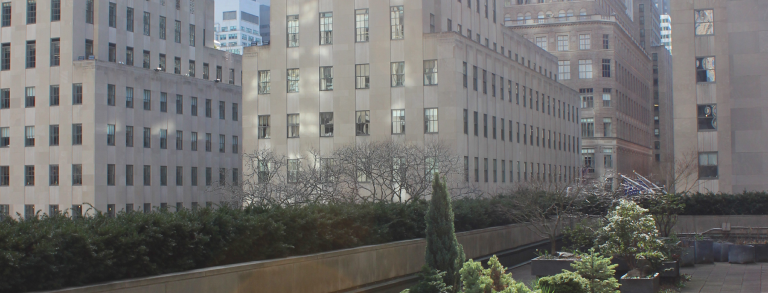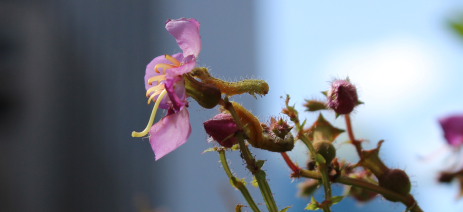I HAVE BEEN the steward of a unique, urban garden for several years. It comprises two parallel terraces just a few floors above street level at Rockefeller Center in New York City, planted over 20 years ago as a rock garden. There are 98 troughs raised on pedestals, with shallow, inset green roof plantings around their base. It is hand watered.
As our cities grow and become denser, we’ll need to get better at incorporating pockets of nature into the built environment. I envision an urban future with more green spaces, managed less intensively yet wisely designed, as if putting ecological systems in motion rather than designing stable gardens. With this in mind, I have been renovating aged areas of the garden with new species, chosen less for their individual beauty and more for their ecosystem attributes. It is a great garden for plant trials because of its maturity, diversity, and patchwork of microhabitats. Managing it has revealed what works and doesn’t among skyscrapers.
Over time, this hand-watered garden has required less watering and less maintenance. I have experimentally nudged it to better meet the site conditions that exist, including lack of renovation. The site’s complexity took time to learn since beyond the extraordinary physicality of the site there are human rhythms that impact the growing conditions. There is no analogous growing environment in the wild.
What follows are some notes on urban ecology from a plant perspective.
On the roof of the "Today Show," plentiful shade from skyscrapers and a wind-shadow create a microenvironment suitable for temperate forest species. This lush, layered corner of the garden shelters mature and unusual perennials. We continually find signs of wildlife.
A tall narrow canyon with sheer ‘walls’ will funnel wind more directly than a stepped canyon, where buildings of different heights break up airflow. Within troughs, small shrubs intercept wind and create protected sites for more tender undergrowth.
Three thousand pounds (1,360 kg) of confetti is dropped in upwind Times Square on New Year’s Eve. Heat from the crowd pushes it back up in a plume of air before it finally lands. Some blows through the canyons of 48th and 49th street and settles around the troughs as a colorful, visual diagram of the micro-wind patterns at this growing site. A wind eddy on the 49th Street terrace collects the most confetti; Opuntia humifusa holds on to it the longest.
Unlike quiet roof gardens at the top of buildings, there is often a loud din at terraces near street level. Sound bounces from building surfaces and is bent by wind tunneling through the street canyons. Sound warp is affected by the shape and orientation of a canyon which also, more importantly to a plant, affects temperatures and wind dynamics.
Alpine plants are well adapted to some of the conditions created by skyscrapers, like high winds. Cushion plants hug rocks, minimizing the amount of airflow across the leaves. This in turn minimizes water loss.
Greenroof plants here must endure shallow soil (3/4 inch, 1.9 cm), frost-heaving, overflow flooding, drought from canyon winds, and summer heat. The clay tiles absorb heat during the day and continue releasing heat after the sun is gone. Thus, plants growing next to the tile are oven-baked at night, a time when plant metabolism normally slows down. Part of assessing a plant microenvironment is noting the surrounding building materials, whose varying properties of absorption and reflection alter the growing conditions.
To achieve dense groundcover amid the pavers, I trialed several new species, planting them as plugs en masse. In sun, Lavandula ‘Phenomenal’ and Geranium macrorrhizum ‘Album’ were excellent in both dry and poorly drained areas. Juncus tenuis thrived in a full-sun area prone to flooding. Sisyrinchium ‘Lucerne’ in the same area survived the flooding but not the drought. In an area with more shade, hot tiles and very high winds, I successfully used Anemone sylvestris, Anemone canadensis, and Phegopteris decursive-pinnata. Anemone sylvestris has endured in spite of phytophthora. Installing plants as young and small as possible seems key for perennial success where root space is limited.
In a nod to the New Jersey pine barrens, I’ve trialed Quercus ilicifolia. It has survived long enough in nine inches (23 cm) of soil to produce acorns in the diamond district.
In a nod to David Hosack who started the first U.S. botanical garden on this site in 1801, I trialed Hamamelis virginiana and a few other species from his collection list. Hamamelis does well in nine inches (23 cm) of soil in high winds, providing a top layer to this plant community cluster. It is a favorite bird perch. Illicium ‘Woodland Ruby’ served to shelter other species from the wind but succumbed after two winters. Cercis ‘Forest Pansy’ does well. I am not a bonsai artist, but I have learned much about the growth dynamics of containerized trees from bonsai forums. I root prune to keep them small, and to encourage new root growth near the trunk. Temperature fluctuates the most at the edge of a container, so hair roots at the edges are most vulnerable to heat and freeze.
Garden form in the built environment is limited by invisible parameters: insurance liability, complex building code, the priority of access to building mechanicals, streetlights and security cameras hidden in the hedges. Window washing must happen regularly, and annually the facade is cleaned of soot. This covers the gardens in a fine dust of Indiana limestone, like snow.
Intermittent and reflected light during the day gives way to artificial light at night. As the sun sets, a flashing glow comes from the digital billboards of Times Square. Asclepias tuberosa, home to loud field crickets, is lit from indoors for a few hours each night during office cleaning. The garden is never completely dark.


